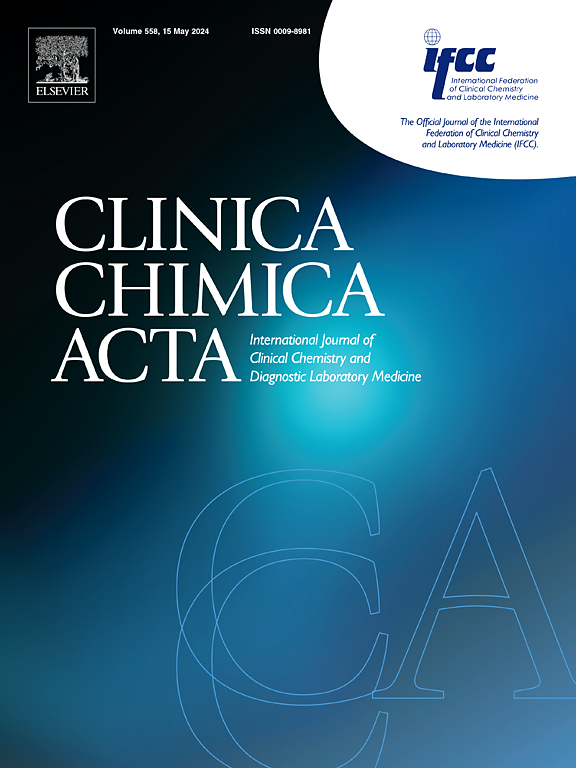MUC1 as a diagnostic biomarker and siRNA-based therapeutic target in breast cancer: A clinical chemistry perspective
IF 2.9
3区 医学
Q2 MEDICAL LABORATORY TECHNOLOGY
引用次数: 0
Abstract
Breast cancer remains the leading cause of cancer mortality in women, and early detection coupled with real-time monitoring of tumor burden are clinical imperatives; yet existing imaging-based screening (e.g., mammography, ultrasound) suffers from sensitivities as low as 60–80% and even lower in dense breasts plus substantial false-positive rates, underscoring the critical need for molecular assays with higher accuracy. Current clinical assays for circulating MUC1 (CA15-3) achieve high specificity but exhibit limited sensitivity in early‐stage disease, underscoring a critical unmet need for more sensitive, multiplexed biomarkers to enable timely intervention. Mass spectrometry-based glycoproteomic workflows offer multiplexed quantification of tumour-associated MUC1 glycoforms, substantially improving analytical specificity and dynamic range. Complementary liquid-biopsy platforms that detect anti-MUC1 autoantibodies further extend lead time for recurrence detection. Concurrently, small interfering RNA (siRNA) therapies targeting MUC1 delivered via ionizable lipid nanoparticles demonstrate efficient tumor accumulation, robust mRNA knockdown, and favourable safety in phase I solid tumor trials. In this review, we critically assess the analytical performance and standardization challenges of current MUC1 assays, evaluate emerging mass spectrometry and immunoarray techniques, and examine chemical and nanocarrier strategies that surmount biological barriers to siRNA delivery. We propose a co-development framework for harmonized companion diagnostics and MUC1-directed RNAi therapeutics under unified regulatory pathways, paving the way for precision, biomarker-driven interventions in breast cancer care.
MUC1作为乳腺癌的诊断生物标志物和基于sirna的治疗靶点:临床化学观点
乳腺癌仍然是妇女癌症死亡的主要原因,早期发现并实时监测肿瘤负担是临床的当务之急;然而,现有的基于成像的筛查(例如,乳房x光检查、超声检查)的灵敏度低至60-80%,在致密乳房中甚至更低,加上大量的假阳性率,强调了对更高精度的分子检测的迫切需要。目前循环MUC1 (CA15-3)的临床检测具有高特异性,但在早期疾病中表现出有限的敏感性,这强调了对更敏感、多用途生物标志物的迫切需求,以实现及时干预。基于质谱的糖蛋白组学工作流程提供肿瘤相关MUC1糖型的多重量化,大大提高了分析特异性和动态范围。检测抗muc1自身抗体的补充液体活检平台进一步延长了复发检测的前置时间。同时,通过可电离脂质纳米颗粒递送靶向MUC1的小干扰RNA (siRNA)疗法在i期实体肿瘤试验中显示出有效的肿瘤积累、强大的mRNA敲除和良好的安全性。在这篇综述中,我们批判性地评估了当前MUC1检测的分析性能和标准化挑战,评估了新兴的质谱和免疫阵列技术,并研究了克服siRNA递送生物障碍的化学和纳米载体策略。我们提出了在统一的调控途径下协调伴随诊断和muc1导向的RNAi治疗的共同开发框架,为乳腺癌治疗的精确、生物标志物驱动的干预铺平了道路。
本文章由计算机程序翻译,如有差异,请以英文原文为准。
求助全文
约1分钟内获得全文
求助全文
来源期刊

Clinica Chimica Acta
医学-医学实验技术
CiteScore
10.10
自引率
2.00%
发文量
1268
审稿时长
23 days
期刊介绍:
The Official Journal of the International Federation of Clinical Chemistry and Laboratory Medicine (IFCC)
Clinica Chimica Acta is a high-quality journal which publishes original Research Communications in the field of clinical chemistry and laboratory medicine, defined as the diagnostic application of chemistry, biochemistry, immunochemistry, biochemical aspects of hematology, toxicology, and molecular biology to the study of human disease in body fluids and cells.
The objective of the journal is to publish novel information leading to a better understanding of biological mechanisms of human diseases, their prevention, diagnosis, and patient management. Reports of an applied clinical character are also welcome. Papers concerned with normal metabolic processes or with constituents of normal cells or body fluids, such as reports of experimental or clinical studies in animals, are only considered when they are clearly and directly relevant to human disease. Evaluation of commercial products have a low priority for publication, unless they are novel or represent a technological breakthrough. Studies dealing with effects of drugs and natural products and studies dealing with the redox status in various diseases are not within the journal''s scope. Development and evaluation of novel analytical methodologies where applicable to diagnostic clinical chemistry and laboratory medicine, including point-of-care testing, and topics on laboratory management and informatics will also be considered. Studies focused on emerging diagnostic technologies and (big) data analysis procedures including digitalization, mobile Health, and artificial Intelligence applied to Laboratory Medicine are also of interest.
 求助内容:
求助内容: 应助结果提醒方式:
应助结果提醒方式:


